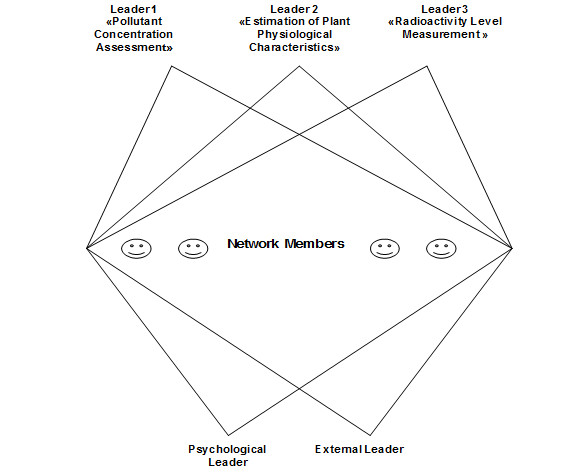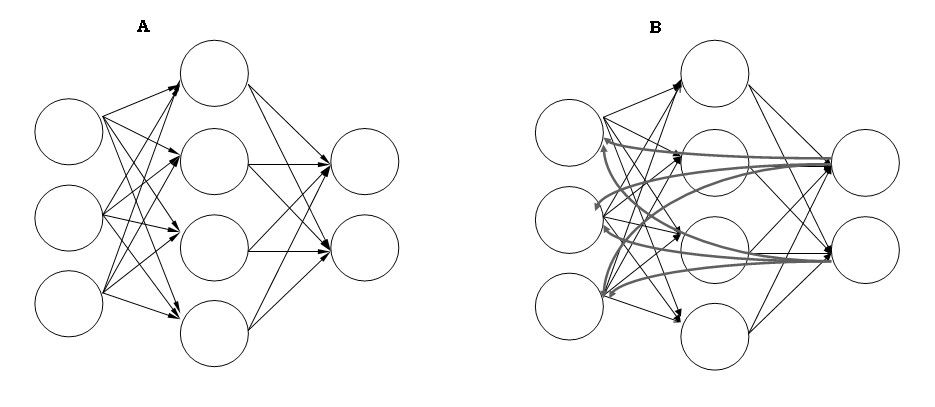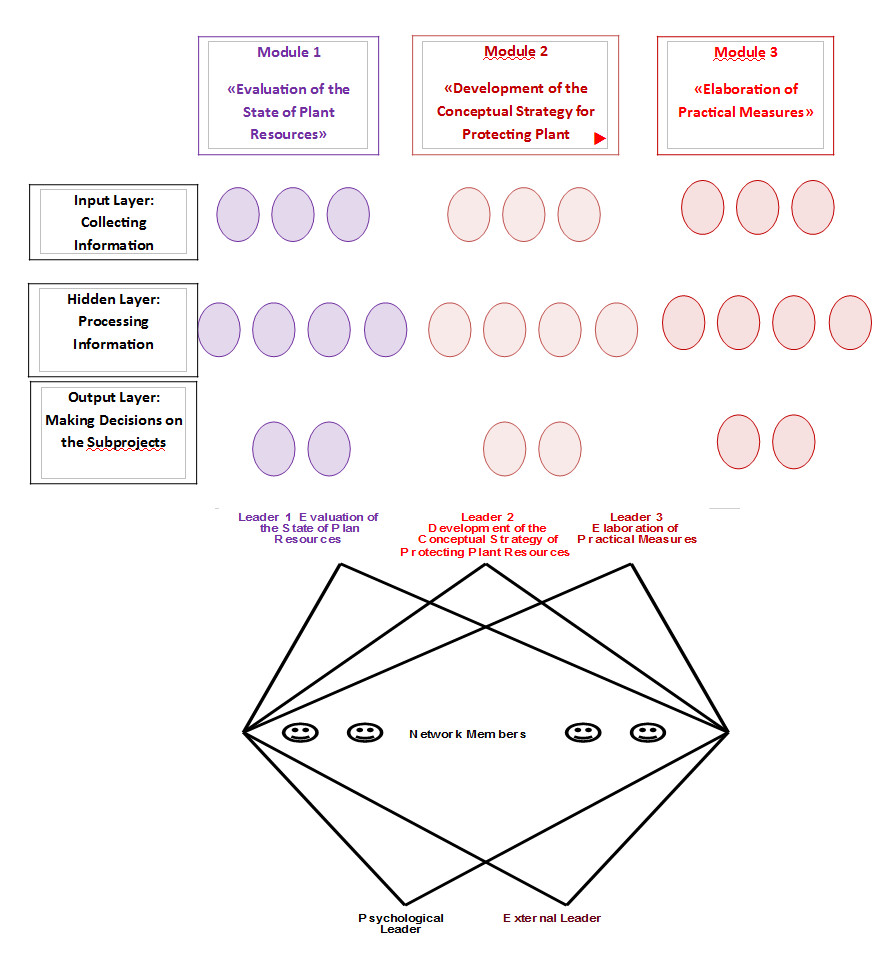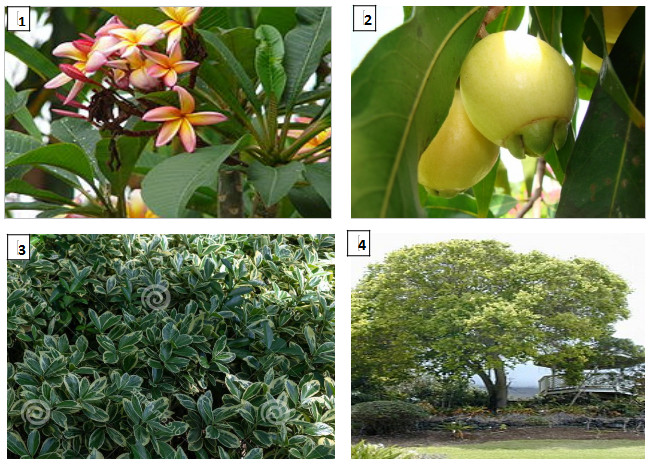Different network paradigms are considered in Table 1 above.
6. Combined Network Structure (Hirama) and the Outline of a Multi-level Network Structure for Environmental Protection. Drawing on recent published works (Oleskin, 2014, 2018), I describe a network structure that combines the features of several network paradigms and is referred to as the hirama (High-Intensity Research And Management Associati
on). This is creative team that is set up for tackling an interdisciplinary project as exemplified by Assessment of the State of Plant Ecosystems (Fig. 2). This general project is broken down into more specific subprojects. For instance, the aforementioned issue can be considered to include the following subprojects:
- Assessing the pollutant concentration and the radioactive background
- Determining the intensity of photosynthesis and of light and dark respiration of plants
- Evaluating the prospects for ameliorating the state of the ecosystems
“In addition, a hirama typically includes an external leader… The individual with this role is responsible for propagandizing hirama-promoted ideas, establishing contacts with other organizations, and shaping the group’s… leisure activities, thus contributing to the development of informal loyal relationships among members” (Oleskin, 2014, p.17). Additional leaders, e.g., an organizational leader, are useful when a hirama is organizing its work and legalizing its status in compliance with the laws of the Chinese People’s Republic.
Fig. 2. Hirama-type network structure applied to the assessment of the state of plant resources (see text for explanations)
Despite subdividing the project into subprojects, the network is not broken down into subnetworks. Its members work, in parallel, on several (ideally on all) subprojects. Only one person, the partial subproject leader, is attached to a particular subproject. The person collects ideas on this subproject. (see: Oleskin, 2014, 2018). A hirama also has a psychological leader who promotes efficient work on all subprojects and helps other partial leaders interact with one another, preventing internal conflict.Apart from the hirama as such, the organizational project in question should be based on the neuronal network paradigm. The nodes of a neuronal network form several different layers that specialize in different stages of handling information and making decisions, from acquiring information (the input layer) via its collective processing (the hidden layer(s)) to making the final decision (the output layer) (Fig. 3).
Fig 3. Neuronal networks combine consecutive (input → hidden layer(s) → output) and parallel information processing. (A) Perceptron; (B) Recurrent neural network with additional feedback links running from the output to the input layer. According to: Oleskin, 2014
Modifying a network-style organizational project concerned with rehabilitative medicine and set forth in the work (Oleskin, 2018), I suggest a complex multi-level structure to provide organizational foundations for a large-scale environmental organization. Its main goal should be Environmental Protection With Special Attention to Regional Plant Resources (for instance, the target area may be the region around Shenzhen). The pilot network structure to be used for attaining the aforementioned goal should include three modules that deal with the following subgoals:
Module 1. Evaluation of the State of Plant Resources
Module 2. Development of the Conceptual Strategy for Protecting Plant Resources
Module 3. Elaboration of Practical Measures for Carrying Out the Conceptual Strategy
Each module combines two different scenarios: (i) a neuronal network and (ii) a multi-level hirama. This can be illustrated using Module 1 (Evaluation of the State of Plant Resources).
All members of this module of the network form three different layers:
-
The input layer: collecting data on photosynthesis intensity, pollutant concentrations, radioactivity levels, etc.
-
The hidden layer: summing up the information obtained and putting together daft documents concerning the flora state
-
The output layer: preparing final reports that contain the decisions made by the whoe module .
The members of the input and hidden layers address all subprojects of Module 1. However, the members of the output layer specialize in one of the following subprojects:
-
Partial leader 1: Measuring the Intensity of Plant Photosynthesis and Light and Dark Respiration
-
Partial leader 2: Determining Pollutant Concentrations.
-
Partial leader 3: Estimating the Radioactivity Background Level
These leaders collect data from all hidden layer members. Each of these partial output-layer leaders supplies the input and the hidden layers with the feedback to be used for error correction (in compliance with the principles of Hopfield recurrent networks).
Module 1 also contains a psychological leader and also an external leader who is tasked with reporting the final results during the meeting of the external leaders of all the Modules. Likewise, Module 2 and Module 3 are internally structured as neuronal networks (with input, hidden, and output layers) and, nevertheless, also represent hiramas because their output layers consist of specialized creative leaders; each of these Modules also has a psychological and an external leader. The external leaders conduct regular meetings, in order to form a higher-order hirama. The projects they carry out represent subprojects within the framework of the more general project (Environmental Protection With Special Attention to Regional Plant Resources) addressed by the whole second-order hirama. The second-order hirama should also have a psychological leader and an external leader (Fig. 4). The external leader is to report the results of the work of the whole structure to the clients that might range from the Chinese government to environmental institutions and to the people at large; the same leader is responsible for contacts with other networks as well as other kinds of structures such as hierarchies and (quasi-)markets with which the second-order hirama has to interact.
Fig. 4. Pilot multi-level network structure for a creative decentralized team specializing in protecting plant resources (based on the scheme in Oleskin, 2018; modified).
The second-order hirama may include additional members with various professional backgrounds ranging from politicians and businesspeople to ordinary citizens like a Chinese janitor called Yu-Jing. They are not involved in the activities of any of the Modules; nevertheless, they can provide their critique concerning the whole project.
To sum up, one of the goals the present work aims to attain is application of the principles of decentralized network structures that exist in the plant world for establishing networked teams specializing in plant resource protection, which is of paramount importance for the flourishing of the economy and the further improvement of the standard of life of present-day China.
Chapter six. EXPERIMENTAL WORK: ESTIMATING THE CONCENTRATIONS OF BIOGENIC AMINES IN PLANT TISSUES
It was mentioned at the beginning of this work that its other important goal was estimating the concentrations of biogenic amines, important informational molecules and communication signals, in some typical plant species that grow in the region around the town of Shenzhen. This is the subject of the following experimental chapter.
1. Literature Data on Biogenic Amines in Plants. The brain cannot operate without neurochemicals (neuromediators, neurotransmitters, neuromodulators, etc.) which are involved in transmitting information among neurons or between neurons and the cells of glands or muscles. Neurochemicals are classified into several groups: (i) biogenic amines including catecholamines (dopamine, norepinephrine, and epinephrine), serotonin, histamine, octopamine, and others; (ii) amino acids (aspartic acid, glutamic acid, -aminobutyric acid (GABA), glycine, etc.); (iii) neuropeptides, such as endorphins, encephalins, dynorphins, substances P and Y, and others; (iv) gaseous neurochemicals such as nitric oxide, carbon monoxide, hydrogen sulfide, etc.; and (v) purines including adenosine, AMP, ADP, ATP, and others.
A large number of neurochemicals are multifunctional agents: they combine the role of neurochemicals with that of hormones or local tissue factors (histohormones). For instance, many neurochemicals perform communicative and regulatory functions in various animals (Dubynin et al., 2010), plants (Roschina, 1991, 2010a, b), fungi, and protozoans (Roshchina, 2010b). It was revealed that amines influence microbial growth, cell aggregation, respiratory electron transfer, membrane potential generation, toxin synthesis, and other processes in microorganisms (reviewed: Oleskin et al., 2017; Oleskin and Shenderov, 2018). Therefore, these substances, apart from being called neurochemicals, should also be referred to as biomediators (Roshchina, 2010a, b).
In particular, the group of neurochemicals known as biogenic amines function as signals and regulators in diverse plant systems (Roschina, 1991, 2010a, b, c). Suffice it to point out that catecholamines are released not only by animals but also by plants in response to stress. Stressed tomatoes, e.g., those incubated at low temperatures, produce significant catecholamine amounts (Lyte, 2014). Serotonin accelerates the development of plants as exemplified by radish seed germination (Roschina, 1991), and this is attributable to its similarity to the plant hormone auxin, or 3-indoleacetic acid (3-IAA).
“The development of the vegetative microspores of the common horsetail Equisetum arvense is stimulated by serotonin, dopamine, and norepinephrine (Roshchina, 2010a). Dopamine and serotonin also promote the development of the pollen of Hippeastrum hybridum (Roshchina, 2010a). Of special interest are the effects of acetylcholine on the motility of intracellular structures, plant cells, and whole plants, including protoplast contraction, cytoplasm cyclosis, stomata opening, nastic movements, and processes in membranes such as ion channel opening. For instance, “in Nitella cells, a decrease in cytoplasm movement is observed at an acetylcholine content of 10-7-10-6 М in the medium, and the movement is completely arrested at still higher acetylcholine concentrations… Epinephrine and norepinephrine slow down cyclosis in the cells of this charophyte at approximately the same concentrations” (Roshchina, 2010a). It is known that numerous plant species of various taxonomic groups synthesize neurochemicals, including catecholamines (dopamine, norepinephrine, and epinephrine), serotonin, histamine, and acetylcholine; they contain enzymes that are involved in their biosynthesis, transport, and degradation” (Oleskin and Shenderov, 2018). In response o touching, mimosa leaves collapse, and this response involves a norepinephrine-dependent system (Roschina, 2010c).
Apart from multicellular (flowering) plants, the present work also addresses communication in unicellular plants such as the green algae Scenedesmus. To the author’s knowledge, they have not yet been researched with respect to the effects of neurochemicals on them. Therefore, our data on growth stimulation and also fluorescence decrease (indicative of more efficient photosynthetic light energy conversion) presented in this work (see below) are novel. Notwithstanding, green unicellular algae are microorganisms, and, therefore, it should be pointed out that studies on neurochemiclas-produced effects in microbial systems have been reported in the literature.
Synthesis of neuroactive compounds by microorganisms forms a part of microbial endocrinology, an interdisciplinary area of research that was envisioned by Mark Lyte (1993) as the intersection between two apparently unrelated fields of science, microbiology and neurology that is focused on neurochemical agents that are identical in the host organism and the microbiota (Lyte, 1993). Susequently, Lyte emphasized bidirectional communication in the microbiota-host system by means of hormonal and neuroactive substances: “Microbial endocrinology is defined as the study of the ability of microorganisms to both produce and recognize neurochemicals that originate either within the microorganisms themselves or within the host they inhabit” (Lyte, 2014, p.3). Microbial endocrinology actually emphasizes the fact that neuroactive substances formed both by multicellular organisms and microorganisms consititute an “universal language” that enables communication between representatives of different kingdoms and empires of life (Mazzoli & Pensione, 2016)
In the first part of the experimental work, biogenic amines, important plant signals and regulators, were quantitatively determined in the leaf tissue of several tree species growing in the Dayun Park of the town of Shenzhen. In its second part, the results of our research on the effects of exogenous neurochemicals (dopamine, histamine, and serotonin) on the growth and chlorophyll fluorescence yield in the green alga Scenedesmus is reported.
2. Materials and Methods.
2.1. Studies on biogenic amine concentrations in plants
The plant species used for measuring biogenic amine concentrations were as follows (Fig. 5):
1. Plumeria rubra L. cv. acutifolia.
2. Syzigium jambos (L.) Alston
3. Buxus megistophylla (or Euonymus japonicas cv. aureoma)
4. Cinnamomum bodinieri Levl.
P. rubra L. cv. acutifolia, originally imported from Central America and Mexico, is used in China as a medicinal plant, apart from being cultivated as a decorative species (Fig. 4). Also several parts of the S. jambos tree are used medicinally as a tonic or a diuretic (Subhadrabandhu, 2001). The leaf decoction is applied to sore eyes, also serves as an expectorant and treatment for rheumatism (World Agroforestry Center website). The ever-green shrub B. megistophylla (box, or boxwood) is only used in topiary and wood carving. C. bodinieri belongs to the group of plants used to produce the spice cinnamon (from the inner bark; Ravindran, 2003).
In this work, frozen leaf samples were disintegrated using a mortar with Quartz sand at 0oC in 0.1 N HCl ; the debris were removed by centrifugation (20,000 g, 20 min).
Fig. 5. Plant species tested in this work for the presence of biogenic amines.1, P. rubra; 2, S. jambos; 3, B. megistophylla; 4, C. bodinieri.
The biogenic amines dopamine (DA), norepinephrine (NE), and serotonin (5-HT) were separated by high-performance liquid chromatography (HPLC) HPLC with an amperometric detection system. A LC-304T chomatographer (BAS, West Lafayette, USA) with a Rheodyne 7125 injector was used; the volume of the loop used for applying samples was 20 l. The tested biogenic amines were separated on a reverse-phase ReproSil-Pur column (ODS-3, 4х100 mm, 3 Dr.Majsch GMBH, Elsico, Moscow). A PM-80 pump (BAS, USA) was used; the elution rate of the mobile phase was 1.0 ml/min at a pressure of 200 atm. The mobile phase contained 0.1 M citrate-phosphate buffer with 1.1 mM octanesulfonic acid, 0.1 mM EDTA, and 9% acetonitrile (pH 3.0). The measurements were carried out using an LC-4B electrochemical detector (BAS, USA) with a glass-carbon electrode (+0.85 V) against an Ag/AgCl reference electrode. The samples were scanned with the Multichrome 1.5 (Ampersand) hardware—software system. All reagents used for the assay were analytical grade. The chromatographer was calibrated using a mixture of the tested biogenic amines; the concentrations of all these substances were 500 nM. The amine concentrations contained in the samples were calculated by the internal standard method that is based on determining the ratio between the peak area in the standard mixture and that in the samples (Oleskin et al., 2014).
2.2. Studies on the effects of exogenous neurochemicals on the growth and chlorophyll fluorescence in the green alga Scenedesmus
The alga Scedesmus was cultivated in the light at 24oC in the medium with the following composition: An actively growing culture was used as inoculum that contained 107cells/cm3 (which corresponded to an optical density of 0.004 at = 710 nm). The culture was grown until the OD value reached a plateau level. Experimental systems contained 100 M of dopamine, histamine, or serotonin that were added at inoculation as 1% of freshly prepared aqueous solutions with neurochemical concentrations of 10 mM: the control system was supplemented with an equal volume of water at inoculation. All neurochemicals were analytic grade, purchased from the Sigma company (USA).
Algal cells were counted in fields of view and calculated for a culture volume of 100 ml.
Fluorescence and OD were measured using a spectrophotometer—fluorimeter device.
3. Results
3.1. Studies on biogenic amine concentrations in plants
Using HPLC with an amperometric detector (Table 2), it was demonstrated that the total fraction of disintegrated leaves of the tree species Plumeria rubra L. cv. acutifolia, Syzigium jambos (L.) Alston, Buxus megistophylla (or Euonymus japonicas cv. aureoma), and Cinnamomum bodinieri Levl. contained relatively high concentrations of the biogenic amines serotonin (5-hydroxytryptamine, 5-HT), norepinephrine (NE), and dopamine (DA). The leaves of the tested plants, except B. megistophylla, also contained 3-methyltryptamine (3-MT). These concentrations were in the order of micromoles per 1 kg of leaf weight (Table 2).
The tested leaves lacked detectable amounts of epinephrine (E) and the catecholamine precursor 2,3-dihydrophenylalanine (DOPA).




